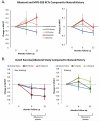Reevaluating measures of disease progression in facioscapulohumeral muscular dystrophy
- PMID: 23406877
- PMCID: PMC3602208
- DOI: 10.1016/j.nmd.2013.01.008
Reevaluating measures of disease progression in facioscapulohumeral muscular dystrophy
Abstract
Recent advances in the understanding of the molecular pathophysiology of facioscapulohumeral muscular dystrophy (FSHD) have identified potential therapeutic targets. Consequently, an accurate understanding of disease progression in FSHD is crucial for the design of future clinical trials. Data from 228 subjects in 3 clinical trials and 1 natural history study were compared to examine disease progression in FSHD. All studies utilized the same techniques for manual muscle testing and maximum voluntary isometric contraction testing. Both techniques yield a total strength score that can be followed over time as an indicator of disease progression. Whereas natural history data showed a decrease in strength over 1 year, there was an apparent increase in strength at 6 months in 2 of the 3 clinical trials in both the placebo and treatment groups, that persisted for up to 1 year for maximum voluntary isometric contraction testing. Variability estimates from the clinical trial data were consistent with those seen in the natural history data. Patients in clinical trials in FSHD may have better outcomes than those in natural history studies, regardless of treatment assignment, emphasizing the importance of placebo groups and the need for caution when interpreting the strength results of controlled and uncontrolled trials.
Copyright © 2013 Elsevier B.V. All rights reserved.
Figures


References
-
- Flanigan KM, Coffeen CM, Sexton L, Stauffer D, Brunner S, Leppert MF. Genetic characterization of a large, historically significant Utah kindred with facioscapulohumeral dystrophy. Neuromuscul Disord. 2001;11:525–9. - PubMed
-
- Mostacciuolo ML, Pastorello E, Vazza G, et al. Facioscapulohumeral muscular dystrophy: epidemiological and molecular study in a north-east Italian population sample. Clin Genet. 2009;75:550–5. - PubMed
-
- Padberg GW. Thesis. University of Leiden; Leiden, the Netherlands: 1982. Facioscapulohumeral disease.
Publication types
MeSH terms
Grants and funding
- K23 AR055947/AR/NIAMS NIH HHS/United States
- T32 NS07338-20/NS/NINDS NIH HHS/United States
- 1P01NS069539-01/NS/NINDS NIH HHS/United States
- T32 NS007338/NS/NINDS NIH HHS/United States
- P01 NS069539/NS/NINDS NIH HHS/United States
- 1K23AR055947/AR/NIAMS NIH HHS/United States
- KL2 RR024136/RR/NCRR NIH HHS/United States
- U54 NS048843/NS/NINDS NIH HHS/United States
- R01 NS061795-01A2/NS/NINDS NIH HHS/United States
- R01 AR054366/AR/NIAMS NIH HHS/United States
- U01 NS061795/NS/NINDS NIH HHS/United States
- U54NS048843-08/NS/NINDS NIH HHS/United States
LinkOut - more resources
Full Text Sources
Other Literature Sources

